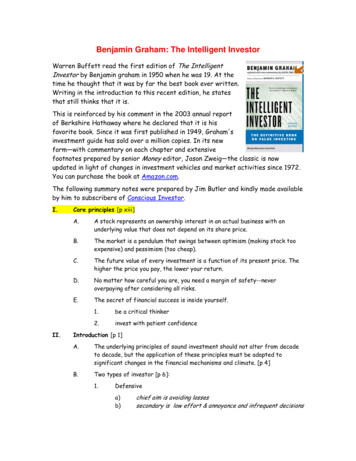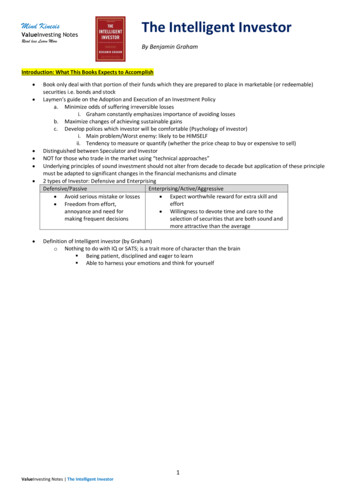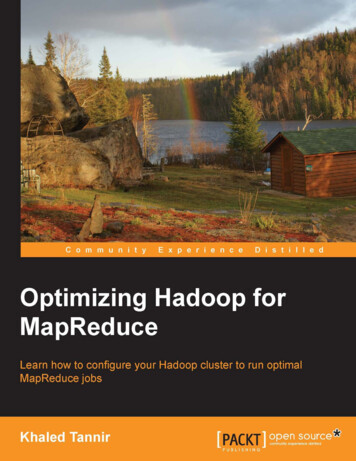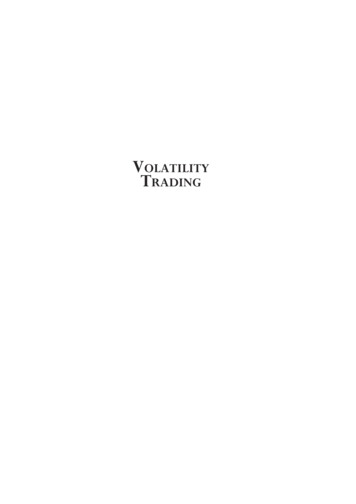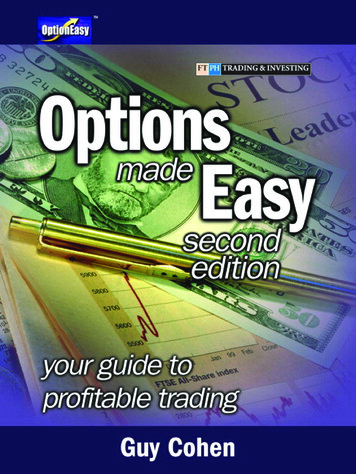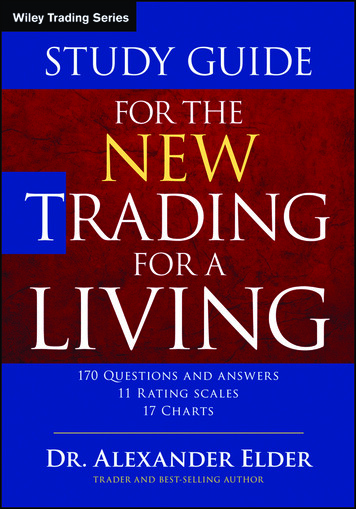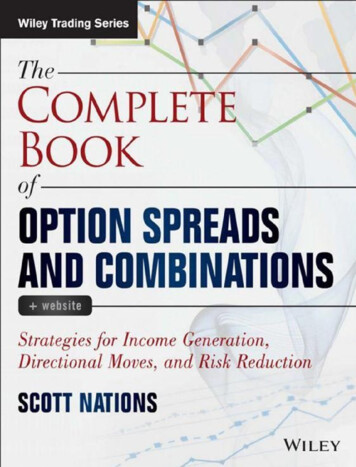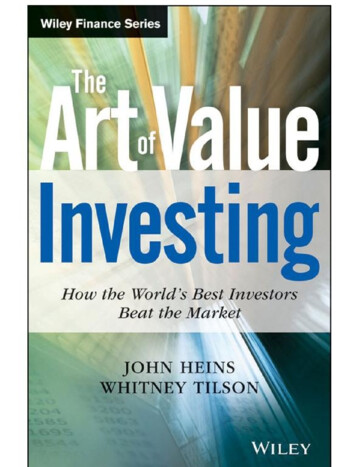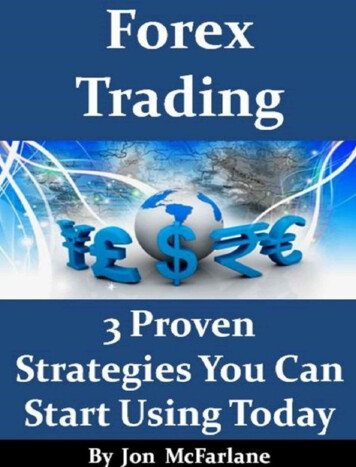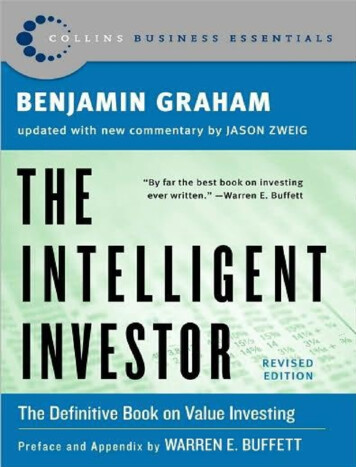
Transcription
The IntelligentInvestorA Book of Practical CounselRevised EditionBenjamin GrahamUpdated with NewCommentary by Jason Zweig
To E.M.G.
Through chances various, throughallvicissitudes, we make our way .Aeneid
ContentsEpigraphPreface to the Fourth Edition, byWarren E. BuffettA Note About BenjaminGraham, by Jason ZweigIntroduction: What This BookExpects to Accomplish
Commentary on the Introduction1. Investment versusSpeculation: Results to BeExpected by the IntelligentInvestorCommentary on Chapter 12. The Investor and InflationCommentary on Chapter 23. A Century of Stock-MarketHistory: The Level of StockPrices in Early 1972
Commentary on Chapter 34. General Portfolio Policy:The Defensive InvestorCommentary on Chapter 45. The Defensive Investor andCommon StocksCommentary on Chapter 56. Portfolio Policy for theEnterprising Investor:Negative ApproachCommentary on Chapter 6
7. Portfolio Policy for theEnterprising Investor: ThePositive SideCommentary on Chapter 78. The Investor and MarketFluctuationsCommentary on Chapter 89. Investing in InvestmentFundsCommentary on Chapter 910. The Investor and His
AdvisersCommentary on Chapter 1011. Security Analysis for theLay Investor: GeneralApproachCommentary on Chapter 1112. Things to Consider AboutPer-Share EarningsCommentary on Chapter 1213. A Comparison of FourListed Companies
Commentary on Chapter 1314. Stock Selection for theDefensive InvestorCommentary on Chapter 1415. Stock Selection for theEnterprising InvestorCommentary on Chapter 1516. Convertible Issues andWarrantsCommentary on Chapter 16
17. Four ExtremelyInstructive Case HistoriesCommentary on Chapter 1718. A Comparison of EightPairs of CompaniesCommentary on Chapter 1819. Shareholders andManagements: DividendPolicyCommentary on Chapter 1920. “Margin of Safety” as the
Central Concept ofInvestmentCommentary on Chapter 20PostscriptCommentary on PostscriptAppendixes1. The Superinvestors ofGraham-and-Doddsville2.ImportantRulesConcerning Taxability ofInvestment Income and
Security Transactions (in1972)3.TheBasicsofInvestmentTaxation(Updated as of 2003)4. The New Speculation inCommon Stocks5. A Case History: AetnaMaintenance Co.6. Tax Accounting forNVF’s Acquisition ofSharon Steel Shares7.TechnologicalCompanies as InvestmentsEndnotesAcknowledgments from JasonZweig
IndexAbout the AuthorsCreditsCopyrightAbout the Publisher
The text reproduced hereis the Fourth RevisedEdition,updatedbyGraham in 1971-1972 andinitially published in 1973.The numbered chapternotes are original toGraham—bolded text inthese notes is by Jason
Zweig.Jason Zweig’s new noteswithin Graham’s chaptersare designated by anasterisk or a cross.
Preface to the FourthEdition,by Warren E. BuffettI read the first edition of this
book early in 1950, when Iwas nineteen. I thought thenthat it was by far the bestbook about investing everwritten. I still think it is.To invest successfully overa lifetime does not require astratospheric IQ, unusualbusiness insights, or insideinformation. What’s neededis a sound intellectualframeworkformakingdecisions and the ability to
keepemotionsfromcorroding that framework.This book precisely andclearly prescribes the properframework. You must supplythe emotional discipline.Ifyoufollowthebehavioral and businessprinciplesthatGrahamadvocates—and if you payspecial attention to theinvaluable advice in Chapters8 and 20—you will not get a
poor result from yourinvestments. (That representsmore of an accomplishmentthan you might nd on the effort andintellect you apply to yourinvestments, as well as on theamplitudes of stock-marketfolly that prevail during yourinvesting career. The sillierthe market’s behavior, thegreater the opportunity for the
business-like investor. FollowGraham and you will profitfrom folly rather thanparticipate in it.To me, Ben Graham wasfar more than an author or ateacher. More than any otherman except my father, heinfluenced my life. Shortlyafter Ben’s death in 1976, Iwrote the following shortremembrance about him intheFinancialAnalysts
Journal. As you read thebook, I believe you’llperceive some of the qualitiesI mentioned in this tribute.
Benjamin Graham1894–1976Several years ago BenGraham, then almost eighty,expressed to a friend thethought that he hoped every
day to do “something foolish,somethingcreativeandsomething generous.”The inclusion of that firstwhimsical goal reflected hisknack for packaging ideas ina form that avoided anyovertones of sermonizing orself-importance. Although hisideas were powerful, theirdelivery was unfailinglygentle.
Readers of this magazineneed no elaboration of hisachievements as measured bythe standard of creativity. It israre that the founder of adiscipline does not find hiswork eclipsed in rather shortorder by successors. But overforty years after publicationof the book that broughtstructure and logic to adisorderly and confusedactivity, it is difficult to thinkof possible candidates for
even the runner-up position inthe field of security analysis.In an area where much looksfoolish within weeks ormonths after publication,Ben’sprincipleshaveremained sound—their valueoften enhanced and betterunderstood in the wake l structures. Hiscounsel of soundness broughtunfailing rewards to his
followers—even to those withnatural abilities inferior tomore gifted practitioners whostumbled while followingcounsels of brilliance orfashion.A remarkable aspect ofBen’s dominance of hisprofessional field was that heachieved it without thatnarrowness of mental activitythat concentrates all effort ona single end. It was, rather,
the incidental by-product ofan intellect whose breadthalmost exceeded definition.Certainly I have never metanyone with a mind of similarscope. Virtually total recall,unending fascination withnew knowledge, and anability to recast it in a formapplicabletoseeminglyunrelated problems madeexposure to his thinking inany field a delight.
But his third imperative—generosity—was where hesucceeded beyond all others. Iknew Ben as my teacher, myemployer, and my friend. Ineach relationship—just aswithallhisstudents,employees, and friends—there was an absolutely openended,no-scores-keptgenerosity of ideas, time, andspirit. If clarity of thinkingwas required, there was nobetter place to go. And if
encouragement or counselwas needed, Ben was there.Walter Lippmann spoke ofmen who plant trees thatother men will sit under. BenGraham was such a man.Reprinted from the FinancialAnalystsJournal,November/December 1976.
A Note About BenjaminGraham by Jason ZweigWho was Benjamin Graham,and why should you listen to
him?Graham was not only oneof the best investors who everlived; he was also the greatestpractical investment thinkerof all time. Before Graham,money managers behavedmuch like a medieval guild,guidedlargelybysuperstition, guesswork, andarcane rituals. Graham’sSecurity Analysis was thetextbook that transformed this
musty circle into a modernprofession. 1AndTheIntelligentInvestor is the first book everto describe, for individualinvestors, the emotionalframework and analyticaltools that are essential tofinancial success. It remainsthe single best book oninvesting ever written for thegeneral public. The IntelligentInvestor was the first book I
read when I joined ForbesMagazine as a cub reporter in1987, and I was struck byGraham’s certainty that,sooner or later, all bullmarkets must end badly. ThatOctober, U.S. stocks sufferedtheir worst one-day crash inhistory, and I was hooked.(Today, after the wild bullmarket of the late 1990s andthe brutal bear market thatbegan in early 2000, TheIntelligent Investor reads
moreever.)propheticallythanGraham came by hisinsights the hard way: byfeeling firsthand the anguishof financial loss and bystudying for decades thehistory and psychology of themarkets. He was bornBenjamin Grossbaum on May9, 1894, in London; his fatherwas a dealer in china dishesand figurines.2 The family
moved to New York whenBen was a year old. At firstthey lived the good life—witha maid, a cook, and a Frenchgoverness—on upper FifthAvenue. But Ben’s fatherdied in 1903, the porcelainbusiness faltered, and thefamily slid haltingly intopoverty. Ben’s mother turnedtheirhomeintoaboardinghouse;then,borrowing money to tradestocks “on margin,” she was
wiped out in the crash of1907. For the rest of his life,Benwouldrecallthehumiliation of cashing acheck for his mother andhearing the bank teller ask,“Is Dorothy Grossbaum goodfor five dollars?”Fortunately, Graham won ascholarship at Columbia,where his brilliance burst intofull flower. He graduated in1914, second in his class.
Before the end of ,philosophy, and mathematics—asked him to join thefaculty. He was all of 20years old.Insteadofacademia,Graham decided to give WallStreet a shot. He started as aclerk at a bond-trading firm,soon became an analyst, thena partner, and before long
wasrunning hisowninvestment partnership.The Internet boom and bustwould not have surprisedGraham. In April 1919, heearned a 250% return on thefirst day of trading for SavoldTire, a new offering in theboomingautomotivebusiness; by October, thecompany had been exposedas a fraud and the stock wasworthless.
Graham became a masterat researching stocks inmicroscopic,almostmolecular, detail. In 1925,plowing through the obscurereports filed by oil pipelineswith the U.S. InterstateCommerce Commission, helearned that Northern PipeLine Co.—then trading at 65per share—held at least 80per share in high-qualitybonds. (He bought the stock,pestered its managers into
raising the dividend, andcame away with 110 pershare three years later.)Despite a harrowing loss ofnearly 70% during the GreatCrash of 1929–1932, Grahamsurvived and thrived in itsaftermath,harvestingbargains from the wreckageof the bull market. There isno exact record of Graham’searliest returns, but from1936 until he retired in 1956,
his Graham-Newman Corp.gained at least 14.7%annually, versus 12.2% forthe stock market as a whole—one of the best long-termtrack records on Wall Streethistory.3How did Graham do it?Combining his extraordinaryintellectual powers withprofound common sense andvast experience, Grahamdeveloped his core principles,
which are at least as validtoday as they were during hislifetime:A stock is not just aticker symbol or anelectronic blip; it is anownership interest in anactual business, with anunderlying value thatdoes not depend on itsshare price.Themarketisa
pendulum that foreverswingsbetweenunsustainable optimism(which makes stocks tooexpensive)andunjustifiedpessimism(which makes them toocheap). The intelligentinvestor is a realist whosells to optimists andbuys from pessimists.The future value ofevery investment is afunction of its present
price. The higher theprice you pay, the loweryour return will be.No matter how carefulyou are, the one risk noinvestorcanevereliminate is the risk ofbeing wrong. Only byinsistingonwhatGrahamcalledthe“margin of safety”—never overpaying, nomatter how exciting aninvestment seems to be
—can you minimizeyour odds of error.The secret to yourfinancial success isinside yourself. If youbecome a critical thinkerwho takes no Wall Street“fact” on faith, and youinvestwithpatientconfidence, you can takesteady advantage of eventhe worst bear markets.By developing yourdiscipline and courage,
you can refuse to letother people’s moodswings govern yourfinancial destiny. In theend,howyourinvestments behave ismuch less important thanhow you behave.The goal of this revisededition of The IntelligentInvestor is to apply Graham’sideas to today’s financialmarkets while leaving his text
entirely intact (with theexception of footnotes forclarification).4 After each ofGraham’s chapters you’ll finda new commentary. In thesereader’s guides, I’ve addedrecent examples that shouldshow you just how relevant—andhowliberating—Graham’s principles remaintoday.I envy you the excitementand enlightenment of reading
Graham’s masterpiece for thefirst time—or even the thirdor fourth time. Like allclassics, it alters how weview the world and renewsitself by educating us. Andthe more you read it, thebetter it gets. With Graham asyourguide,youareguaranteed to become avastlymoreintelligentinvestor.
Introduction:What This Book Expects toAccomplishThepurpose of this book is
to supply, in a form suitablefor laymen, guidance in theadoption and execution of aninvestmentpolicy.Comparatively little will besaid here about the techniqueofanalyzingsecurities;attention will be paid chieflyto investment principles andinvestors’ attitudes. We shall,however, provide a number ofcondensed comparisons ofspecific securities—chiefly inpairs appearing side by side
in the New York StockExchange list—in order tobring home in concretefashiontheimportantelements involved in specificchoices of common stocks.But much of our space willbe devoted to the historicalpatterns of financial markets,in some cases running backover many decades. To investintelligently in securities oneshould be forearmed with an
adequate knowledge of howthe various types of bondsand stocks have actuallybehavedundervaryingconditions—some of which,at least, one is likely to meetagaininone’sownexperience. No statement ismoretrueandbetterapplicable to Wall Street thanthe famous warning ofSantayana: “Those who donot remember the past arecondemned to repeat it.”
Our text is directed toinvestors as distinguishedfrom speculators, and our firsttask will be to clarify andemphasize this now all butforgotten distinction. We maysay at the outset that this isnot a “how to make amillion” book. There are nosure and easy paths to richeson Wall Street or anywhereelse. It may be well to pointup what we have ju
The Intelligent Investor was the first book I. read when I joined Forbes Magazine as a cub reporter in 1987, and I was struck by Graham’s certainty that, sooner or later, all bull markets must end badly. That October, U.S. stocks suffered their worst one-day crash in history, and I was hooked. (Today, after the wild bull market of the late 1990s and the brutal bear market that began in early .
